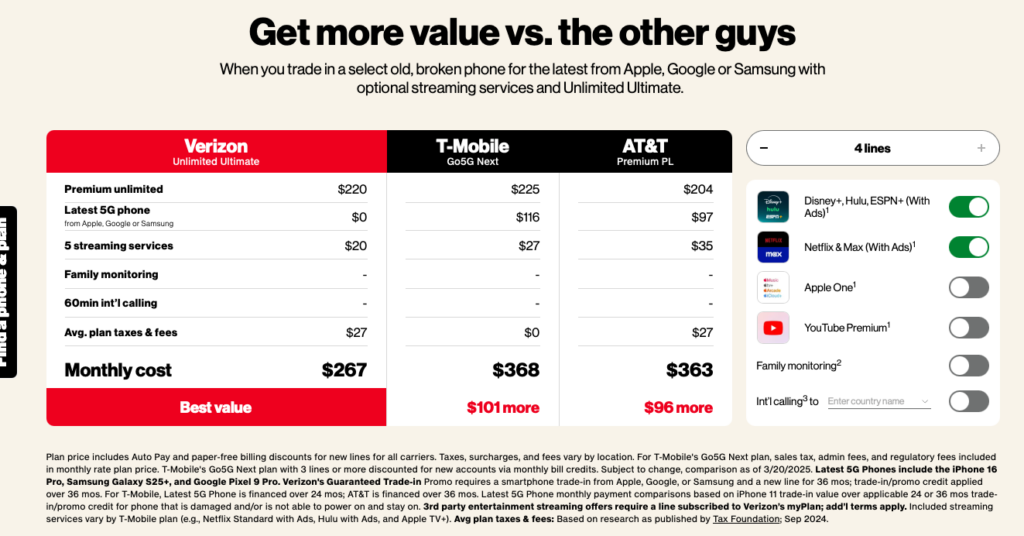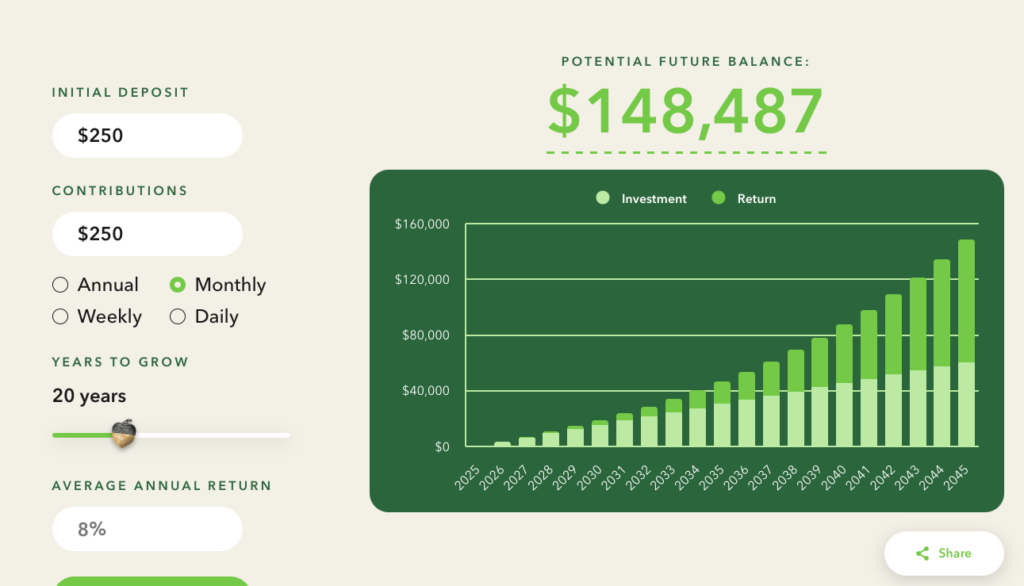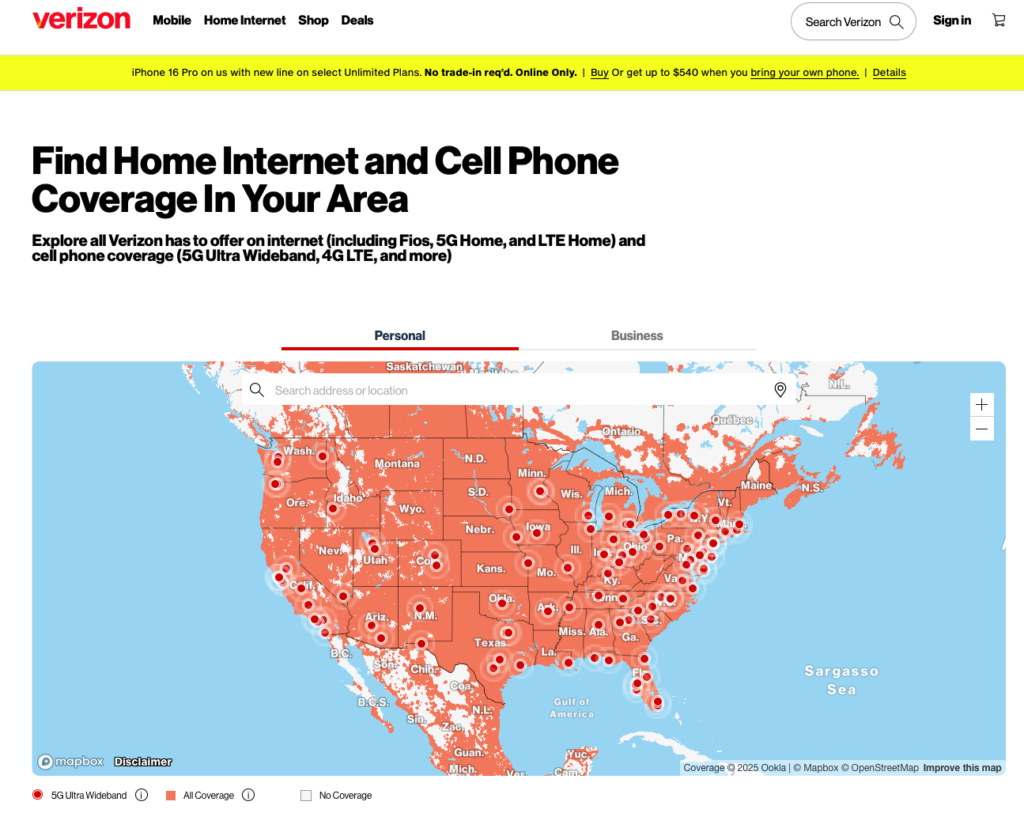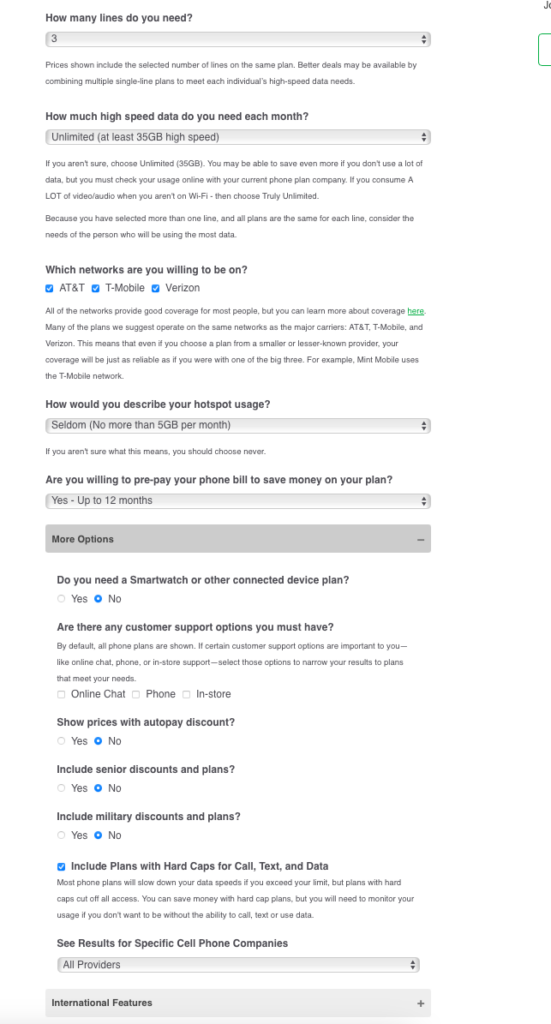I just finished a post on cellphones, here, so I thought it was a good time to talk about service for our phones.
Like it or not, our cellphone has become an appendage. Many would rather be missing an arm, leg or hand rather than go a day without their beloved phone. I get it. I can’t imagine getting in the car and not having my phone attach to my car and bring up my latest playlist.
But while buying a cellphone is a huge expense – anywhere from a couple hundred dollars to well over a thousand, keeping it online is an even more expensive proposition.
Say I’m a family of 4. All of us have phones so we have an unlimited data plan from Verizon. According to Verizon, I’d pay $267 per month, or $3,204 per year, or $32,040 for ten years.
You laugh…but your phone and your plan aren’t going away. You’ll be paying this for 20, 30 or 40 years. Maybe more.

We won’t go into it here, but I’m guessing that T-Mobile and AT&T have a similar page on their websites that shows they are cheaper.
The point is that this is a big expense. My first new car that I bought in 1985 had a monthly payment of $250. I paid it off in 4 years. This $250 ain’t going away. We’ll pay it for life.
What would happen if I invested the $250 each month in an S&P 500 fund? Here’s what our friends at acorns say.

You get it. This is a big expense, with a huge lost opportunity cost.
Alternatives
I’m not going to browbeat you and tell you to sell your phone and cancel your plan. We all know this isn’t going to happen.
The good news is that there are lots of alternatives for us.
When I got my first cell phone, I could choose between AT&T, Verizon or T-Mobile (or Sprint, which is now part of T-Mobile).
Starting in the 1990’s, but becoming much more ubiquitous recently, mobile virtual network operators (MVNO) showed up.
MVNO
It’s expensive to set up a mobile network, lease tower space for your equipment, purchase bandwidth from the government, and run a telecommunications company. It’s exhausting just writing that sentence. An MVNO is a guy who shows up and acts as a broker, reselling unused bandwidth to us, the consumer. It’s probably a little more complicated than that. You can read about it here.
But the key for us is that there are little guys out there who are offering plans that run on the T-Mobile, AT&T and Verizon networks. It’s basically the same service for a much lower price.
You’ve probably heard of Mint Mobile, Visible, Consumer Cellular and Tello. These are MVNOs. More here.
Some of these MVNOs have plans that start at $15 per month.
Requirements
Here we go again. We talked about this in the cellphone post and we’ll talk about it here as well. What do we need?
Oh, I have to have unlimited data.
Maybe.
But, as my dad used to say when lining up a putt, let’s analyze this.
Data
I remember in the old days when families used to go out to dinner and talk. Today’s restaurants are full of tables where each person is typing on their cellphone. I suspect the next step in evolution will be the end of the spoken word.
But we use lots of data. We’re streaming 4k movies, downloading songs, sending high resolution photos (mostly of our food). That takes lots of bandwidth so we need lots of data.
But how much do we need?
I am towards the end of my cycle. How do I know? My iPhone tells me. You Android people are on your own. You’ll have to Google it. Which is funny because Google makes the Android operating system which is complicated so you have to use their search engine to find how to find things.
But I digress…On iPhone, I tap on settings, cellular.

I used a whopping 6.25 GB of data. Half of it Apple Music. I listen constantly. In the past, I used Pandora. My data never went over 2 GB.
Then I tap usage and see:

My cycle ends in about a week, so I’ll probably get up to around 8 GB.
If I log in to T-Mobile, I can see more info:

I’ve blacked-out the names and numbers but you can see my usage up top. My wife and my wife’s mom, who is on our plan, use almost nothing.
Who’s using 248 GB of Data????
A while back we moved from Spectrum internet to T-Mobile wireless home internet. I have a box which is basically a big cellphone with a router attached. It connects wirelessly to the T-Mobile network and broadcasts an SSID just like any other router. Wireless home internet – who would have thought? $50 per month with unlimited data and no throttling.
My data requirement is probably 10 GB to be safe. My wife and wife’s mom could get away with 1 or 2 GB.
And if I were smart, I’d dump Apple Music, go back to the free version of Pandora, and then I could get by with 2 GB. Something to think about…
Network Coverage
Here’s a biggee – arguably more important than data. Data isn’t much good if we don’t get coverage in the places where we use our phone.
At one point, I could never get a signal at the Shaw’s supermarket plaza down the street. I still have a very weak signal at my daughter’s house.
The signal at home, where I’m using wireless internet, is fabulous. And everywhere else I go seems fine. T-Mobile shows great coverage on its map, but do your homework because T-Mobile wouldn’t work for my daughter.
Research
The coverage maps for the big 3 are pretty accurate according to some reading I’ve done and by my experience with T-Mobile and with Verizon before.
All carriers have something like this. And you can put in a zip code to zoom in.

The maps are a great start, but the T-Mobile coverage map says I’ll have great coverage at my daughter’s house. Ask around a bit before committing.
Support
I hesitate to make this a requirement. It may be a nice to have.
How much support do we really need? I bought a new iPhone in October. I put it down next to my old iPhone, tapped a couple of keys and scanned a code, and 10 minutes later everything, including the phone number was transferred over.
We then transferred my old phone to my wife and my wife’s old phone to her mom. No calls to T-Mobile.
Depending on your own experience with technology, this may move up or down on the priority list.
A Story (or 2) About Support
A few months back, I was having periodic internet outages with my T-Mobile wireless router.
I called T-Mobile and got a friendly young man from right here in the US of A. Why do I call this out? I recently had an experience with Xfinity. Their support people are overseas. Communication was just a little bit harder.
So, the T-Mobile guy takes a look and can see the dropped internet signal happening periodically. I had tried a new (refurbished) T-Mobile modem and new sim card and that hadn’t helped.
He said he needed to talk to someone at the T-Mobile store which was not open yet. He promised to call me back at 10am. Yeah, right.
Promptly at 10, my phone rings. The rep says they won’t give me the upgraded modem with my current internet plan. He is going to upgrade me to the top-tier plan. I’ll then go to the store and exchange my old modem for the new 5G modem. He’ll call me back, make sure it worked out and then he’ll downgrade my plan.
Homerun!! He was helpful, creative, and he called back 2x exactly when he said he would.
2 years ago I called T-Mobile to shop for a lower rate. The rep found me a couple of things I could do to save money without sacrificing any service or features. She then asked how old I was.
I suspected she was looking for a date, but sadly she was only looking to see if I qualified for the 55+ plan. I did. She swapped me over and I got off a 20 minute call with $20 per month savings.
So the quality of customer support may not be a hard requirement, but it can be a differentiator. I might be able to save a few bucks by moving, but so far, the exceptional service has made it worth my while to stay.
Choosing
There are dozens of websites that will help you find the best plan for you. Here’s one of my favorites from clark.com. I love Clark. He’s cheaper than me.
Clark asks a few questions and then shows you plans that meet your requirements.

Other Considerations
T-Mobile also gives me free Netflix. I had Netflix before I moved so having T-Mobile pay for it saves me $10 per month. Be aware that if you are taking advantage of a “deal” and you are getting an extra service, you aren’t saving anything. Work that into your cost-benefit carefully.
T-Mobile had a promotion where they paid off my, and my wife’s phones when we joined. This came as a bill credit over 24 months. This was about $1,500 in our pocket.
My T-Mobile plan has unlimited international data. This was nice when I traveled for work, and when my wife and I went to Europe. While you can buy a sim card overseas and swap it in, if you travel often, this could save time and money.
Data caps are handled differently across plans. While this isn’t an issue on an unlimited plan, if you sign up for a capped plan, make sure you know what happens if you exceed your limit.
- Some shut you off when you hit the limit.
- Some allow you to continue, but they’ll throttle data, meaning your screen loads like 1990’s AOL through a dial-up modem.
- Some will charge you for the next tier, and may move you permanently to a higher data tier
Payment
I pay my T-mobile bill monthly. Same when I had Verizon.
But looking at a couple of MVNOs today, they have 3,6, and 12 month plan options and we need to pay in advance. A 12 month plan is cheaper but we pay the full year upfront.
Also, most monthly payment plans offer a discount for setting up automatic payments. I love auto-pay and all my bills are set up for it, but I check each one every month. Accidents happen. I just canceled my mom’s Xfinity TV. With cable only, the bill would be $71 per month. I got an email confirming. The next charge was $306. 3 phone calls, several chats and 5 reps later, I’m still hoping for a correction. This is how I know their customer service stinks.
Wrap-Up
Cell service is largely a commodity. They are all basically the same as long as there is good coverage where we are and where we expect to be, and they can handle our data needs.
Service can be a differentiator. It may be worthwhile to you, but most stuff is self service and some of the MVNOs have been very good about implementing self-service features on their websites and apps. This is how they charge less. That and not having to build infrastructure.
Shop
Take some time, look what’s out there. I shop service regularly. To date, T-mobile has saved me money for cell phone service and internet, and so far, it hasn’t been worth it for me to change. But I keep looking.
The Mint Mobile $15 per month deal looks pretty enticing. I may have to try.
Let me know your experience and any recommendations.
Quick Math
- Mint Mobile: 4 lines, 5GB each, $15 each = $60 per month = $720 per year = $7200 over 10 years.
- Verizon: 4 Lines, unlimited data, a phone upgrade and a couple of streaming services, $267 per month, $3,204 per year, $32,040 for 10 years.
Would you limit yourself to a paltry 5 GB, give up that 1x phone upgrade and the lifetime streaming services to save $24,000 over 10 years?
That’s something to think about.

